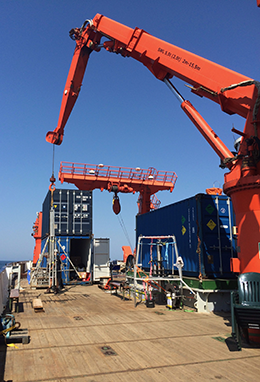Revelatory relationship
A new study of the ecology of an enigmatic group of novel unicellular organisms by LMU scientists supports the idea hydrogen played an important role in the evolution of Eukaryota, the first nucleated cells.
08.01.2020
 One of the most consequential developments in the history of biological evolution occurred approximately 2 billion years ago with the appearance of the first eukaryotes – unicellular organisms that contain a distinct nucleus. This first eukaryotic lineage would subsequently give rise to all higher organisms including plants and animals, but its origins remain obscure. Some years ago, microbiologists analyzed DNA sequences from marine sediments, which shed new light on the problem. These sediments were recovered from a hydrothermal vent at a site known as Loki’s Castle (named for the Norse god of fire) on the Mid-Atlantic Ridge in the Arctic Ocean. Sequencing of the DNA molecules they contained revealed that they were derived from a previously unknown group of microorganisms. Although the cells from which the DNA originated could not be isolated and characterized directly, the sequence data showed them to be closely related to the Archaea. The researchers therefore named the new group Lokiarchaeota.
One of the most consequential developments in the history of biological evolution occurred approximately 2 billion years ago with the appearance of the first eukaryotes – unicellular organisms that contain a distinct nucleus. This first eukaryotic lineage would subsequently give rise to all higher organisms including plants and animals, but its origins remain obscure. Some years ago, microbiologists analyzed DNA sequences from marine sediments, which shed new light on the problem. These sediments were recovered from a hydrothermal vent at a site known as Loki’s Castle (named for the Norse god of fire) on the Mid-Atlantic Ridge in the Arctic Ocean. Sequencing of the DNA molecules they contained revealed that they were derived from a previously unknown group of microorganisms. Although the cells from which the DNA originated could not be isolated and characterized directly, the sequence data showed them to be closely related to the Archaea. The researchers therefore named the new group Lokiarchaeota.
Fig: A crane is used to deploy the rig used to recover sediment cores from the seabottom. Source: W. Orsi
Archaea, together with the phylum Bacteria, are the oldest known lineages of single-celled organisms. Strikingly, the genomes of the Lokiarchaeota indicated that they might exhibit structural and biochemical features that are otherwise specific to eukaryotes. This suggests that the Lokiarchaeota might be related to the last common ancestor of eukaryotes. Indeed, phylogenomic analysis of the Lokiarchaeota DNA from Loki’s Castle strongly suggested that they were derived from descendants of one of the last common ancestors of Eukaryota and Archaea. Professor William Orsi of the Department of Earth and Environmental Sciences at LMU, in cooperation with scientists at Oldenburg University and the Max Planck Institute for Marine Microbiology, has now been able to examine the activity and metabolism of the Lokiarchaeota directly. The results support the suggested relationship between Lokiarchaeota and eukaryotes, and provide hints as to the nature of the environment in which the first eukaryotes evolved. The new findings appear in the journal Nature Microbiology.
The most likely scenario for the emergence of eukaryotes is that they arose from a symbiosis in which the host was an archaeal cell and the symbiont was a bacterium. According to this theory, the bacterial symbiont subsequently gave rise to the mitochondria – the intracellular organelles that are responsible for energy production in eukaryotic cells. One hypothesis proposes that the archaeal host was dependent on hydrogen for its metabolism, and that the precursor of the mitochondria produced it. This “hydrogen hypothesis” posits that the two partner cells presumably lived in an anoxic environment that was rich in hydrogen, and if they were separated from the hydrogen source they would have become more dependent on one another for survival potentially leading to an endosymbiotic event. “If the Lokiarchaeota, as the descendants of this putative ur-archaeon, are also dependent on hydrogen, this would support the hydrogen hypothesis,” says Orsi. “However, up to now, the ecology of these Archaea in their natural habitat was a matter of speculation.”
Orsi and his team have now, for the first time, characterized the cellular metabolism of Lokiarchaeota recovered from sediment cores obtained from the seabottom in an extensive oxygen-depleted region off the coast of Namibia. They did so by analyzing the RNA present in these samples. RNA molecules are copied from the genomic DNA, and serve as blueprints for the synthesis of proteins. Their sequences therefore reflect patterns and levels of gene activity. The sequence analyses revealed that Lokiarchaeota in these samples outnumbered bacteria by 100- to 1000-fold. “That strongly indicates that these sediments are a favorable habitat for them, promoting their activity,” says Orsi.
He and his colleagues were able to establish enrichment cultures from the Lokiarchaeota in the sediment samples in the laboratory. This enabled them to study the metabolism of these cells using stable carbon isotopes as markers. The results demonstrated that the microorganisms make use of a complex network of metabolic pathways. Moreover, the data confirmed that Lokiarchaea indeed use hydrogen for the fixation of carbon dioxide. This process enhances the efficiency of metabolism, and allows these species to maintain high levels of biochemical activity, in spite of the energy limited conditions of their anoxic natural habitat. “Our experimental evidence the hydrogen hypothesis for the first eukaryotic cell,” says Orsi. “Consequently, the earliest eukaryotes could have originated in oxygen-depleted and hydrogen-rich marine sediments, such as those in which modern Lokiarchaeota are particularly active today.”
Nature Microbiology 2019





